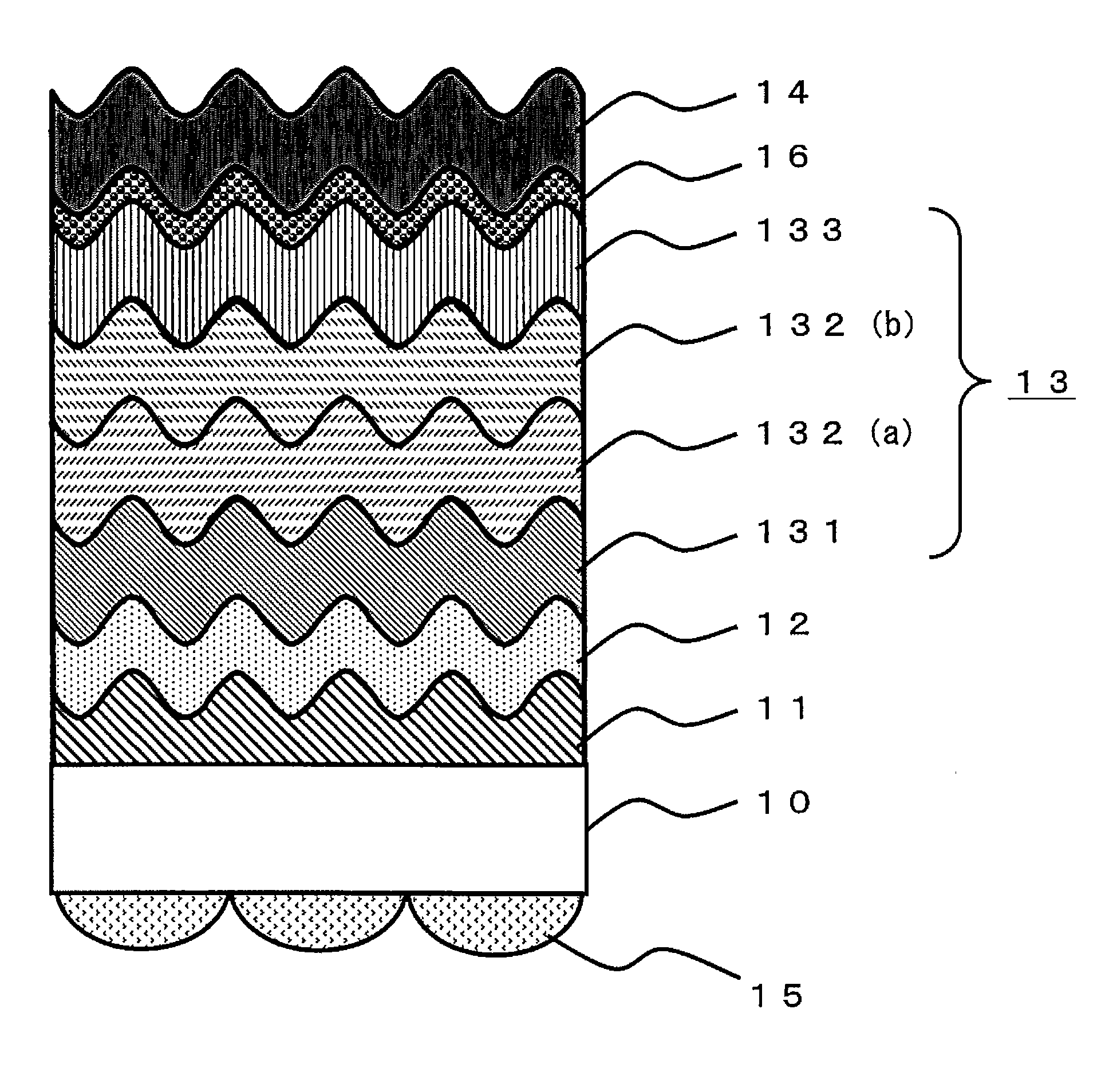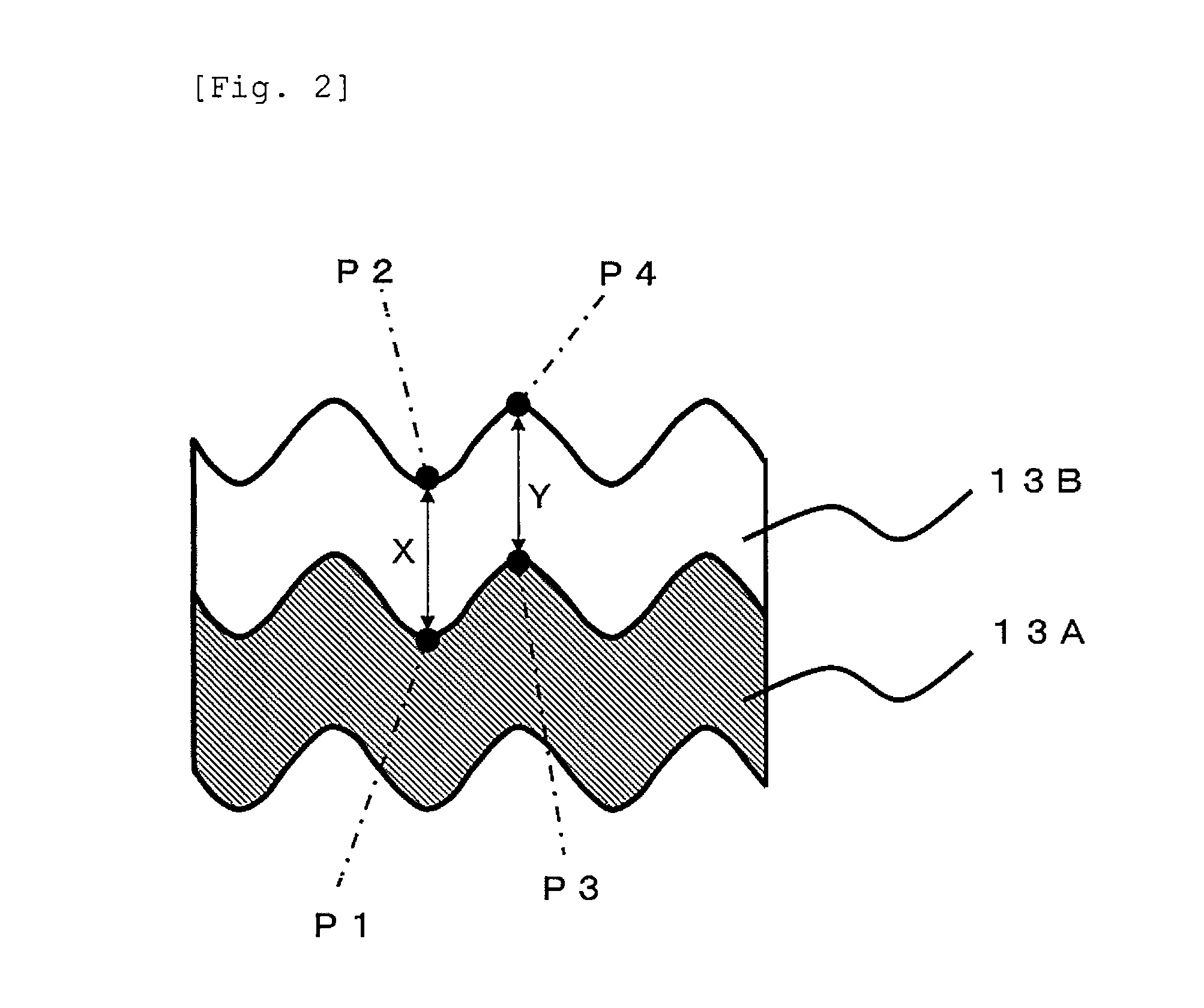Organic el element
a technology of organic elements and elements, applied in the field of organic elements, can solve the problems that the light generated at the organic layer cannot be extracted to the outside sufficiently, and the external extraction efficiency cannot be achieved, so as to achieve the effect of light emission efficiency, improved light extraction efficiency, and higher level
- Summary
- Abstract
- Description
- Claims
- Application Information
AI Technical Summary
Benefits of technology
Problems solved by technology
Method used
Image
Examples
example 1
[0270]An organic EL element having the structure shown in FIG. 11 (the structure of transparent supporting substrate 10 / diffraction grating 11 / transparent electrode 12 / hole transporting layer 131 / light emitting layer 132 / hole blocking layer 134 / electron transporting layer 133 / cathode buffer layer 16 / metal electrode 14 stacked in this order) was manufactured as follows.
[0271]
[0272]First, a b lock copolymer (A) used in a step of preparing a master block (mold) is described.
[0273][Block Copolymer (A)]
[0274]A block copolymer of PS and PMMA (manufactured by Polymer Source Inc,),
[0275]Mn of PS segment=868,000,
[0276]Mn of PMMA segment=857,000,
[0277]Mn of block copolymer=1,725,000,
[0278]Volume ratio of PS segment to PMMA segment (PS:PMMA)=53:47,
[0279]Molecular weight distribution (Mw / Mn)=1.30,
[0280]Tg of PS segment=96° C.,
[0281]Tg of PMMA segment=110° C.
[0282]As the block copolymer (A), a block copolymer being manufactured by Polymer Source Inc, and containing polystyrene (hereinafter, abbr...
example 2
[0319]A diffraction grating (concavity and convexity layer) was manufactured on a glass substrate by employing the same method as in the diffraction grating formation step employed in Example 1. After the diffraction grating was formed on the glass substrate, an organic EL element having a structure as shown in FIG. 13 (the structure of transparent supporting substrate 10 / diffraction grating 11 / transparent electrode 12 / hole transporting layer 131 / first light emitting layer 132 (a) / second light emitting layer 132 (b) / electron transporting layer 133 / cathode buffer layer 16 / metal electrode 14 stacked in this order) was manufactured in the same manner as in Example 1, except that an organic EL element formation step 2 described later was conducted instead of the organic EL element formation step 1.
[0320]In addition, as in the case of Example 1, it was found that a Fourier-transformed image of the diffraction grating obtained in Example 2 showed a circular pattern substantially centered ...
example 3
[0329]A diffraction grating (concavity and convexity layer) was manufactured on a glass substrate by employing the same method as in the diffraction grating formation step employed in Example 1. Subsequently, an organic EL element having a structure of transparent supporting substrate (glass substrate) / diffraction grating / transparent electrode (ITO) / hole transporting layer (TCTA) / light emitting layer (TCTA:7.0% by mass of Ir(ppy)3) / electron transporting layer (TpBi) / cathode buffer layer made of metal-based material (LiF) / metal electrode (Al) stacked in this order was manufactured in the same manner as in Example 1, except that an organic EL element formation step 3 described later was conducted instead of the organic EL element formation step 1.
[0330]In addition, regarding a Fourier-transformed image of the diffraction grating obtained in Example 3, it was found, as in the case of Example 1, that the Fourier-transformed image showed a circular pattern substantially centered at an or...
PUM
 Login to View More
Login to View More Abstract
Description
Claims
Application Information
 Login to View More
Login to View More - R&D
- Intellectual Property
- Life Sciences
- Materials
- Tech Scout
- Unparalleled Data Quality
- Higher Quality Content
- 60% Fewer Hallucinations
Browse by: Latest US Patents, China's latest patents, Technical Efficacy Thesaurus, Application Domain, Technology Topic, Popular Technical Reports.
© 2025 PatSnap. All rights reserved.Legal|Privacy policy|Modern Slavery Act Transparency Statement|Sitemap|About US| Contact US: help@patsnap.com



